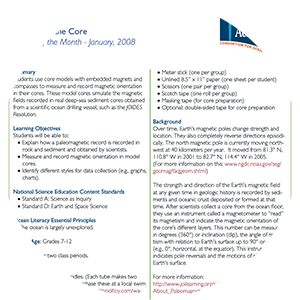Actvity Summary: Students use core models made from swim noodles with embedded magnets and compasses to measure and record magnetic orientation. These model cores simulate the magnetic fields recorded in real deep-sea sediment cores obtained.
- Standard A: Unifying concepts and processes in science
- Standard B: Science as inquiry
- Standard C: Physical science
- Standard E: Earth and space science
- Standard F: Science and technology
- Patterns
- Cause and effect
- System and system models
- Energy and matter
- Stability and change
- Asking questions and defining problems
- Developing and using models
- Planning and carrying out investigations
- Analyzing and interpreting data
- Constructing explanations and designing solutions
- Engaging in argument from evidence
- Obtaining, evaluating, and communicating information
- ESS1. C The history of the planet Earth
- ESS2.A Earth materials and systems
- ESS2.B Plate tectonics and large-scale system interactions
- PS1.A Structure of matter
- PS3.B Conservation of energy and energy transfer
- PS3.C Relationship between energy and forces
- PS4.B Electromagnetic radiation
